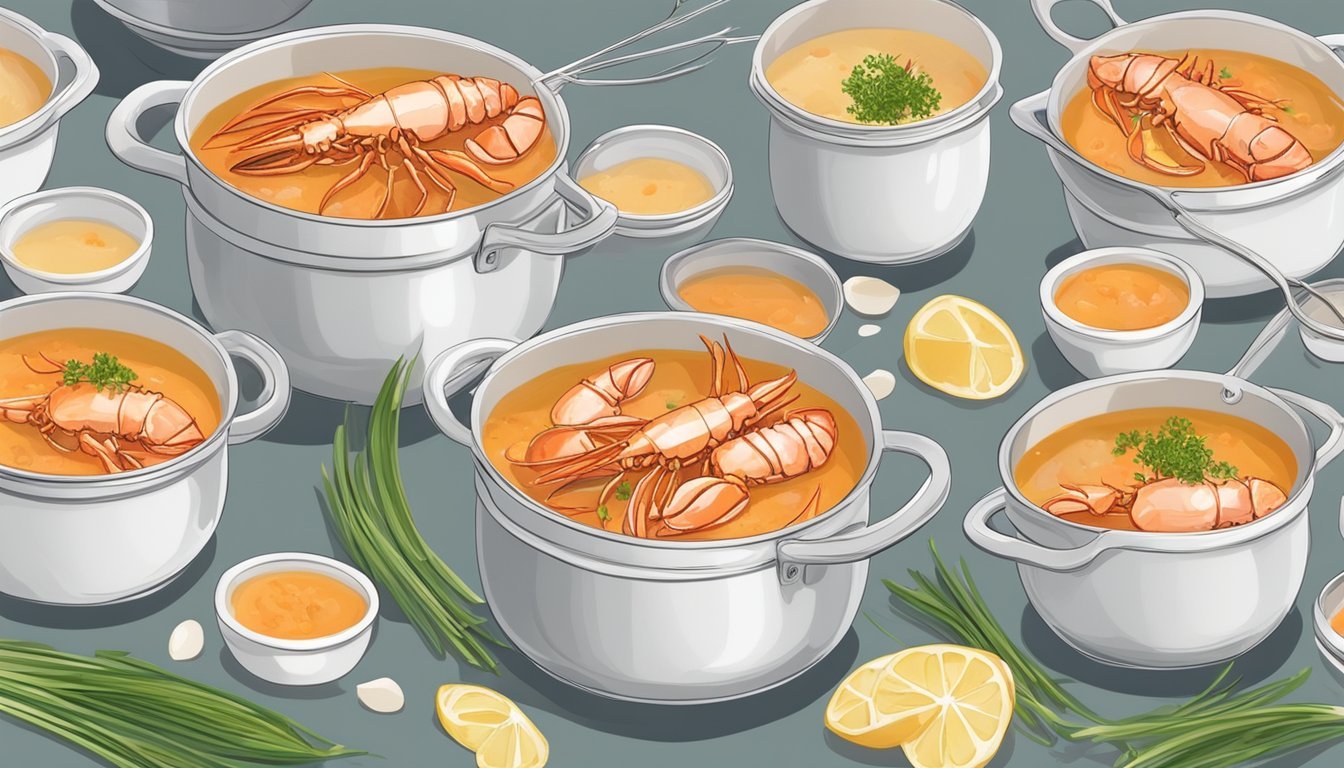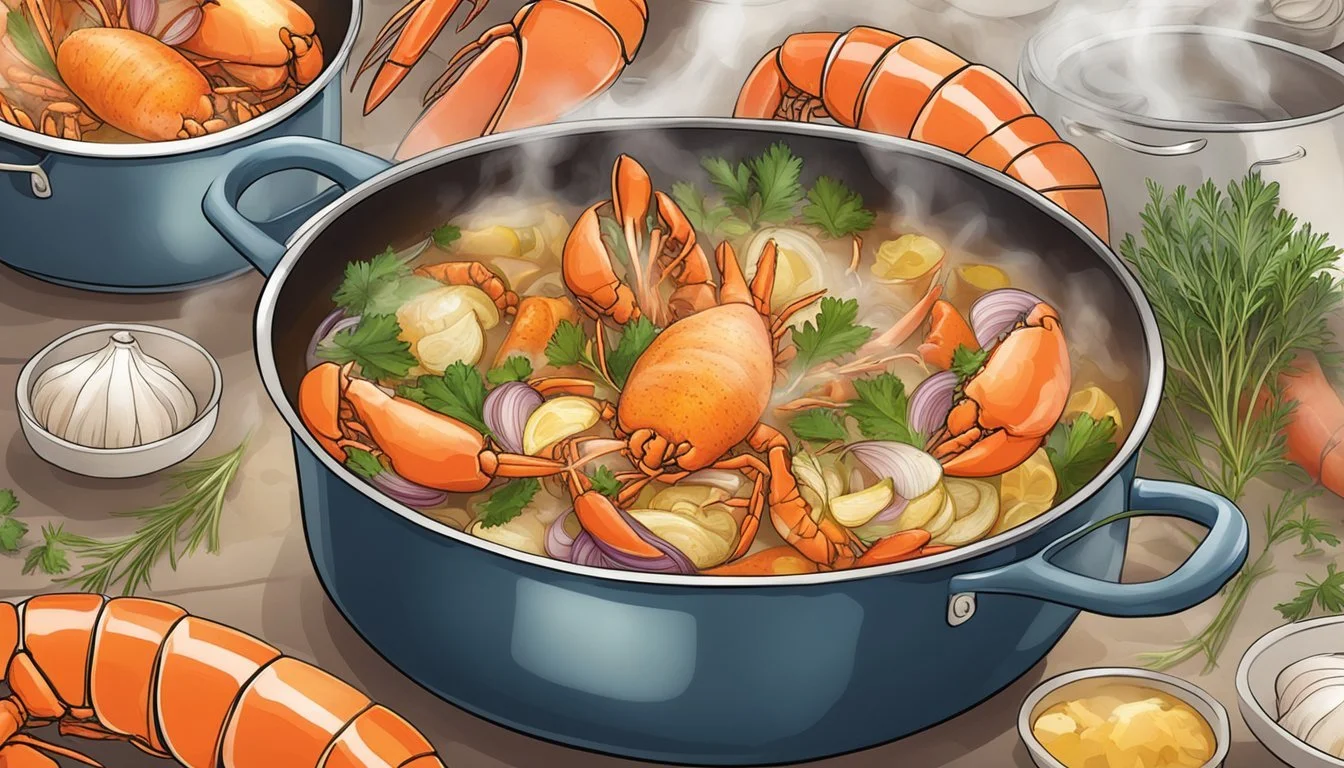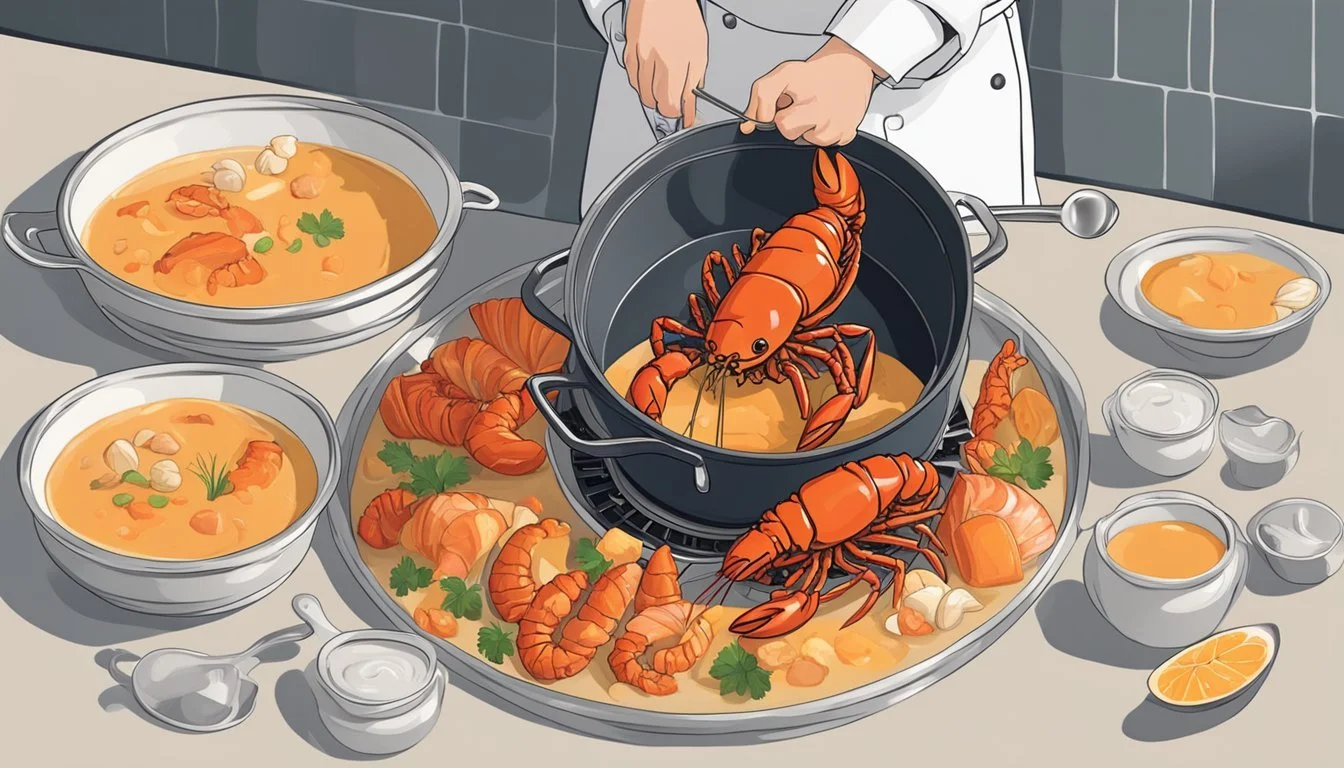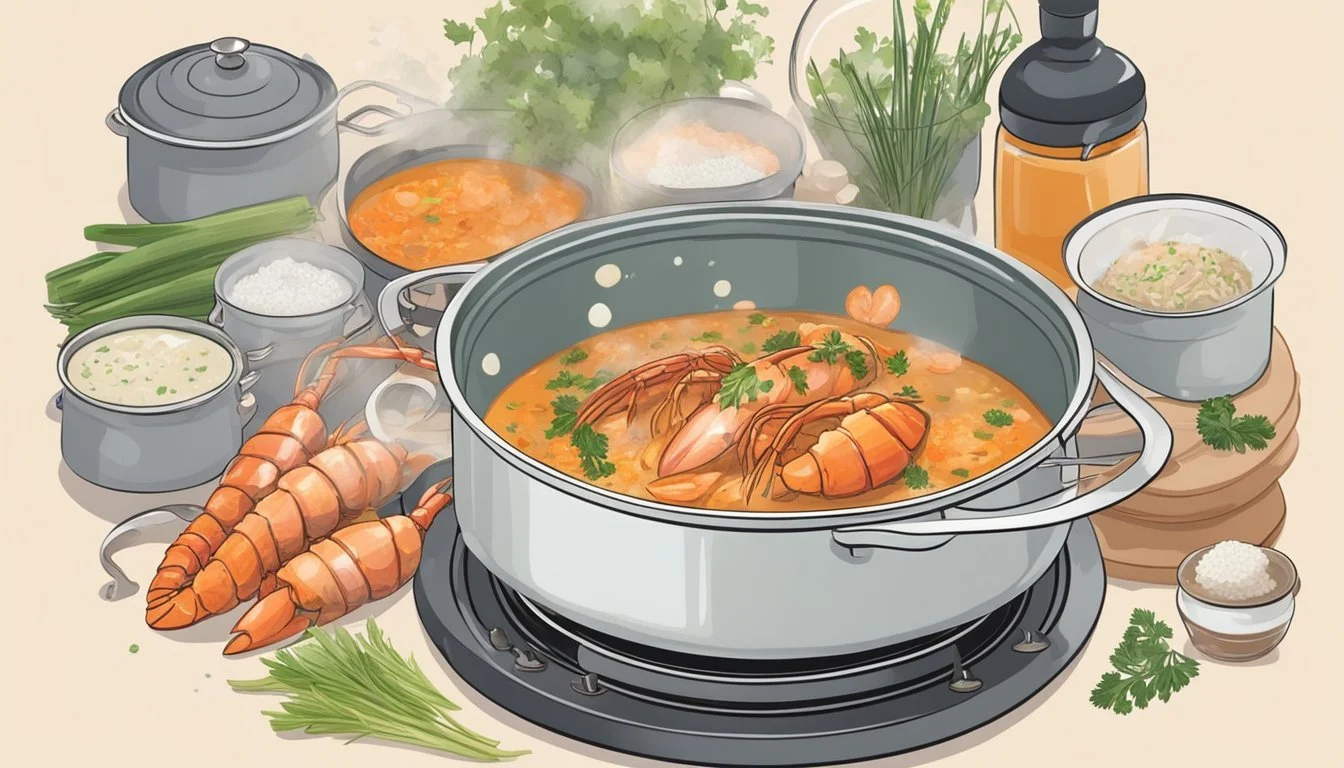How to Make Luxurious Lobster Bisque from Leftover Shells
A Gourmet's Guide to Zero Waste Cooking
Lobster bisque is a rich and creamy soup known for its deep flavor and luxurious texture. It's a gourmet dish that can elevate a simple meal to an exquisite dining experience. By utilizing leftover lobster (What wine goes well with lobster?) shells, home cooks can create this indulgent soup from scratch, ensuring not a single part of this prized crustacean goes to waste. The key to unlocking the bisque's full potential lies in the careful preparation of the shells, which harbor an abundance of flavor.
Starting with the shells of previously enjoyed lobster, chefs can extract a concentrated broth imbued with the essence of the sea. This base forms the heart of the bisque, into which additional layers of flavor are built. The process involves sautéing a mirepoix of onions, celery, and carrots, then simmering the shells with the aromatics before blending and straining to achieve that signature smooth consistency.
The final steps of the bisque involve enriching the strained stock with cream, wine, and a medley of herbs and spices, resulting in a soup that is both comforting and sophisticated. Homemade lobster bisque, made from leftover shells, demonstrates how luxury and sustainability can be artfully combined, offering a satisfying dish that respects the ingredients and delights the palate.
Gathering Ingredients
Creating a luxurious lobster bisque starts with sourcing the highest quality ingredients. Each component plays a vital role in building the flavor profile of the bisque.
Choosing Quality Lobster Shells and Meat
Lobster forms the foundation of the bisque. One should select leftover shells from lobsters that were fresh and properly stored before being cooked. It is crucial to ensure the meat is succulent and flavorful, as it will be added back into the bisque.
Selecting Fresh Vegetables and Herbs
For the aromatic vegetables, gather fresh carrots, celery, and onion; these will be finely diced to provide a flavor base. Garlic should be fresh and firm, ready to be minced. Including a variety of herbs such as thyme, tarragon, and bay leaves will enrich the bisque with their aromatic qualities.
Stocks and Liquids Essentials
The liquids are what bring everything together. Chicken or seafood stock can be used alongside lobster stock to enhance the depth of flavor. White wine and tomato paste are key for adding acidity and richness. Cream will provide a velvety texture, while butter will offer a smooth finish. Stocks and liquids should be measured and prepared beforehand for a seamless cooking process.
Preparation Techniques
Lobster bisque’s depth of flavor is largely due to proper preparation techniques. Meticulous attention to creating stock from leftover shells, sautéing aromatics, thickening the bisque with roux, and pureeing for a velvety texture ensures a luxurious final dish.
Making the Stock from Shells
The stock is foundational to the bisque's flavor. One starts by crushing the leftover lobster shells and sautéing them in a heavy-bottomed pot until they turn a deep red color, releasing their rich flavors. The shells are then simmered in water—often the water used to boil the lobster—to extract their essence. This results in a flavorful stock that serves as the bisque's base.
Creating a Flavorful Base with Aromatics
Aromatics form the second layer of the bisque's taste profile. In a separate pan, one should sauté finely chopped onions, carrots, and celery until they are soft and fragrant. To these vegetables, one may add garlic and tomato paste, continuing to sauté until well blended. This mixture is later incorporated into the simmering stock to infuse it with additional flavors.
Thickening the Bisque with Roux
For a rich and creamy consistency, a roux is prepared. It involves cooking equal parts of butter and flour over a medium heat until a paste forms. This paste, or roux, is then whisked into the lobster stock gradually, thickening the bisque and creating a silkier texture.
Pureeing for a Smooth Texture
Once the bisque is infused with all the flavors, it is then time to blend. An immersion blender can be used directly in the pot to puree the bisque until smooth. Alternatively, one may transfer the bisque in batches to a blender, being careful to secure the lid and blend at a low speed initially to prevent splatter. Pureeing incorporates all components into a cohesive texture.
Cooking Process
In the cooking process for Lobster Bisque, the shells form the flavor base, while simmering extracts their essence, and the addition of cream transforms the bisque into a luxurious soup.
Combining Ingredients for Bisque Base
The chef should begin by sautéing minced onions, celery, and carrots in olive oil over medium heat in a dutch oven. Once the vegetables have softened, they will add the lobster shells, crushing them slightly to fit. The vegetables and shells are then covered in chicken broth or vegetable stock, setting the foundation for a rich bisque.
Simmering the Lobster Bisque
After combining the initial ingredients, the mixture should be brought to a gentle simmer. The chef allows it to simmer for a good hour, during which the stock absorbs the flavors of the lobster shells. This simmering process is crucial as it extracts the subtle taste of the sea from the shells, which is the essence of any shellfish (What wine goes well with shellfish?) bisque.
Incorporating Cream and Seasonings
Once the essence of the lobster has infused the broth, the chef strains the solids, returning the liquid to the dutch oven. They then bring it to a simmer again, gradually stirring in heavy cream. The chef must season the bisque thoughtfully with salt and pepper, tasting as they go. As an option, small pieces of lobster meat can be added to enhance the protein content and provide an indulgent texture.
Final Touches and Serving
As lobster bisque nears completion, careful adjustments to the seasonings and thoughtful choices in garnishing can elevate this creamy soup to a luxurious dining experience. Here's how to give your lobster bisque those final touches before it graces the table.
Adjusting the Seasonings
To verify the bisque's flavor balance, one should taste the soup after it incorporates all ingredients, including the heavy cream. The soup should be thick and creamy. Essential seasonings to adjust at this stage typically include:
Salt: Start with a pinch, taste, and adjust gradually to enhance the flavors.
Black pepper: Freshly ground black pepper adds a hint of spice; add to suit your preference.
Remember, seasonings are best adjusted incrementally to avoid overpowering the delicate lobster flavor.
Suggested Garnishes
Garnishing lobster bisque not only adds to the visual appeal but can also introduce complementary textures and flavors. Ideal garnishes include:
Fresh herbs: Sprinkle chopped chives, fennel fronds, or other fresh herbs lightly to add color and a fresh taste.
Cream: A small swirl of heavy cream or crème fraîche can enrich the soup's creamy consistency.
Presentation is key, so one should add these garnishes just before serving to maintain their vibrant colors and textures.
Pairing with Side Dishes
Lobster bisque is often rich and filling, so it pairs well with lighter side dishes. Consider serving it with:
Salad: A crisp, green salad with a tart vinaigrette dressing can balance the creaminess of the bisque.
Bread: Offer slices of crusty bread for dipping, which can absorb the soup and create a satisfying textural contrast.
Storing and Reheating
After savoring a homemade lobster bisque, proper storage and reheating methods ensure the leftover soup retains its luxurious quality. Lobster bisque leftovers present a unique challenge in preserving the subtle, rich flavors while avoiding spoilage or texture changes.
Best Practices for Storage
For Refrigeration:
Store leftover lobster bisque in the refrigerator if it will be consumed within two to three days.
Transfer the bisque into an airtight container to maintain its freshness and prevent absorption of other odors.
For Freezing:
If a longer storage duration is needed, freezing is a suitable option.
Cool the bisque completely before placing it into the freezer.
Utilize freezer-safe bags or containers and expel as much air as possible to avoid freezer burn.
Properly sealed, lobster bisque can be frozen for up to three months.
Reheating Without Losing Quality
Preheat the oven to 350 degrees Fahrenheit.
Place the bisque in an oven-safe dish and cover it with aluminum foil.
Heat the bisque for 10-15 minutes, or until it is thoroughly warmed throughout.
For a smaller quantity, the stovetop method is preferred.
Pour the bisque into a saucepan.
Reheat on low heat to prevent altering the texture and flavor.
Stirring occasionally, heat the bisque until it's warm, ensuring it does not boil.
In both reheating methods, the bisque should be carefully monitored to avoid overheating, as excessive heat can lead to the bisque separating or becoming too thin. Leftover lobster bisque, when stored and reheated correctly, continues to be a delightful and elegant dish.
Nutritional Information
Lobster bisque, crafted from leftover shells, retains the nutritional bounty of the sea. When prepared with care, it can offer a range of benefits within a balanced diet.
Health Benefits of Lobster and Seafood
Lobster is a seafood that is not only delicious but also packed with vital nutrients. It provides a significant amount of protein essential for muscle repair and growth. Lobster meat is also rich in calcium and potassium, two minerals important for maintaining strong bones and proper heart function. The bisque, commonly enriched with cream, may further contribute to the dish's calcium content, benefiting bone health.
Seafood, in general, includes a variety of nutrients crucial to health. Many types of seafood are abundant in omega-3 fatty acids, which are known for their role in heart health and cognitive function. Lobster and other shellfish often contain vitamins such as B12, supporting nerve function and energy production.
Dietary Considerations
Individuals with specific dietary needs or goals might approach lobster bisque differently. As lobster contains cholesterol, those monitoring their cholesterol intake should enjoy lobster bisque in moderation. Moreover, while lobster is a lean source of protein, lobster bisque can be high in calories and fats due to added ingredients such as cream and butter. Consequently, it may not be suitable for weight loss diets unless portion sizes are controlled.
For those concerned with maintaining a healthy dietary pattern, lobster bisque can be adjusted. One might consider using light cream in place of full-fat options or increasing the proportion of broth to decrease the overall calorie content. Additionally, for individuals seeking to limit their intake of sodium, the seasoning in lobster bisque should be moderated, as this soup can otherwise be high in salt.
Variations and Related Recipes
Luxurious lobster bisque is traditionally made using leftover shells from cold-water lobster tails. However, a variety of seafood options and creative recipe pairings can enhance any culinary experience, making the dish versatile and suitable for special occasions.
Alternative Seafood Options
While lobster bisque is a classic, one can easily substitute or augment with other seafood. Crayfish, when available, can serve as a more economical yet still succulent option. Lobster tails from both cold and warm waters offer unique flavors; the latter being slightly sweeter and the former having a briny, oceanic taste profile. It's important to note that the intensity of the sea flavor will vary based on the kind of shells used.
Creative Leftover Ideas
Lobster bisque is known for its rich flavor, which can be utilized in various dishes. Leftover bisque can be transformed into a creamy sauce for pasta dishes or used as a decadent base for chowders. Here are two ideas:
Lobster Mac and Cheese: Enrich your favorite mac and cheese recipe by mixing in some bisque for an extra luxurious touch.
Hot Crab (What wine goes well with crab?) Dip: Combine bisque with cream cheese, crab meat, and some spices for a warm, enticing appetizer.
Complementary Recipes for Special Occasions
When lobster bisque is featured as a main dish, it pairs wonderfully with complementary side dishes and mains. Here are some examples:
Main Dish: Serve lobster bisque alongside a tender steak or grilled fish for a surf-and-turf experience.
Chowder: Offer a lighter corn or seafood chowder before the rich bisque, allowing your guests' palates to gradually build up to the intensity of the lobster flavor.
By weaving in these variations and related recipes, one can create a diverse menu that showcases the luxurious essence of lobster in each course.






